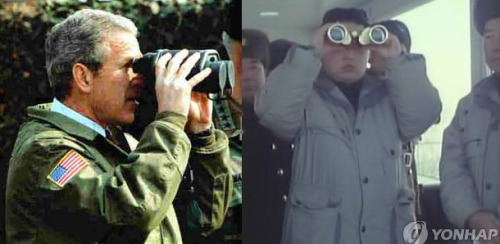The DU Lounge
Related: Culture Forums, Support ForumsAnyone know any thing about binoculours?
I would like to get a pair just for distance and clarity. 99% to look out over water (ie![]() cean) to watch the boats on the horizon. Any one have any ideas??? Thanks in advance!!!
cean) to watch the boats on the horizon. Any one have any ideas??? Thanks in advance!!!
onehandle
(51,122 posts)You don't have to spend a lot. Tascos are the cheapest, Bushnells are mid-range, Olympus and Nikons on the high end.
I've been happy with Bushnells. In the $35 to $55 range. Make sure you can mount them on a tripod.
NYC_SKP
(68,644 posts)I've had telescopes, spotting scopes, and binoculars and I would prefer a higher power telescope with large optics to lower power binoculars for the same money, and possibly a spotting scope as an option.
Go try them all at a sporting goods or hunting supply store and ask to use them outside, for distance.
Binocs will give you stereo vision, but have twice the parts so cost more.
If I had my druthers, if money was no object, I'd love to have a pair of THESE:

Arctic Dave
(13,812 posts)MicaelS
(8,747 posts)Best Binoculars & Binocular Reviews Website
http://www.bestbinocularsreviews.com/
petronius
(26,603 posts)magnified as well, so as you go up in magnification it gets harder to hold them steady. I've always been comfortable with 10x, but 8x is very nice also. Another thought is whether you plan to use them in the evening or when it's darker - larger objective lens (the big end) will pull in more light. And the ratio between the objective diameter and the magnification gives the size of the disk of light landing on your eye - the bigger that is (up to ~ 7 mm or so), the easier it will be. For example, 10X x 50 gives an disk of 5 mm worth of light coming into your eye.
Field of view is another consideration: how wide of an area will you be able to see when looking out. This affect how easily you can see an entire object, and how quickly you can spot things when you raise the binoculars.
Finally, portability is worth thinking about: an extra 1/2 pound means little in the store, but it adds up over 5 miles of trail...
pokerfan
(27,677 posts)like Zeiss or Nikon. Do you want to use them in low light or for astronomy? Then you will want a large objective lens, the second number after the 'x.' If not, then a large objective just adds, bulk, weight and cost. If you will be using them in environments with lots of light, you can go smaller: 40 or 35. Even 25, for maximum portability.
If you wear glasses, look for long eye-relief which will make it easier (or even possible) to use the binocs with eyeglasses.
Power (the first number before the x) is less important. Too much power can make the binoculars hard to stabilize. I have a pair of 10x50 Nikons that took a lot of getting used to.
RiffRandell
(5,909 posts)I received a pair as an xmas gift one year for bird watching and lost them. ![]()
Replaced them with the same brand; they are pretty basic and were inexpensive and work well for watching the birds in our backyard.
krispos42
(49,445 posts)Unless you plan on using a tripod.
Get something that has a quick-focus knob or paddle; the old screw-type focus has been improved upon.
You might be able to pick up a used pair at a pawn shop. Two things to look for in my experience:
1) Look through the big end at something light-colored. Check the optics for cracks, chips, water stains, cloudiness, dirt, dust, etc. Those are readily visible when looking backwards through the binoculars.
2) Look through the small end and try to make sure the optics are properly aligned. My dad has a pair of binoculars that have one side out of alignment with the other. The lines of sight are not parallel. If the optics are not properly aligned your eyes will feel weird. Look at something distant and see if your eyes feel funny or strained.
If you need more power, a modest spotting scope (basically, a ground-orientated small telescope) is useful. You can get one that goes on a regular camera tripod, and they have lots more power. I have a cheap one that works reasonably well; I got it for a gift. It has a variable zoom from 20x to 60x, although I don't usually go past 40x... it becomes very sensitive to vibrations and wind and such.
yortsed snacilbuper
(7,939 posts)
Locut0s
(6,154 posts)I know nothing about binos but they look upside down.